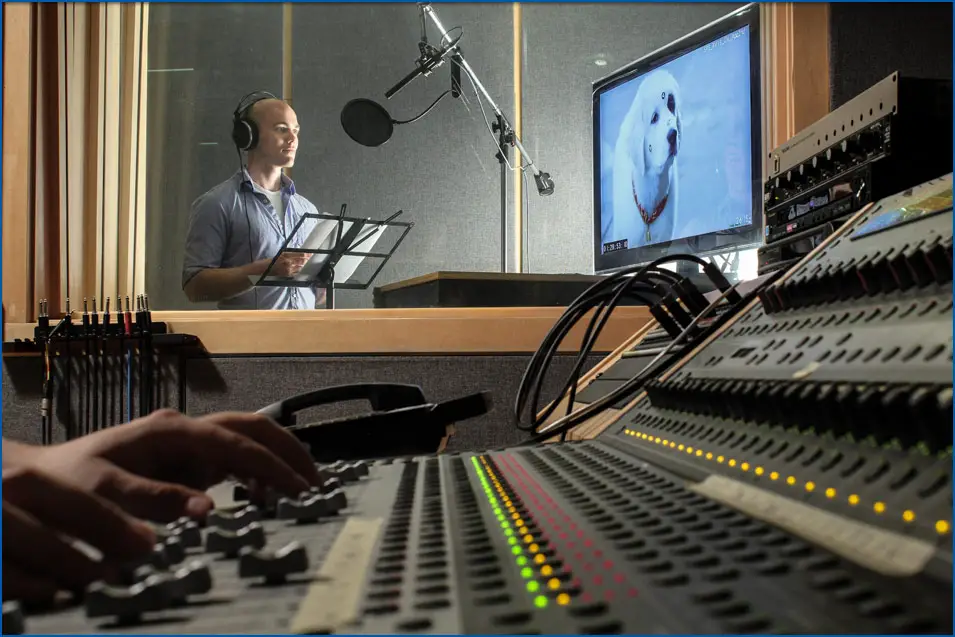
The main objective of recording in the dubbing process is to transfer the voice of an individual to mimic the voice of an original film or dialogue to a decided language. It is audio acting in a studio. The recording should capture all emotions and acting skills of the original actor to make it real.
Where Should A Dub Recording Be Done?
A recording should be done in a soundproof studio, with a control room and a booth. This environment should be well padded to ensure it does not capture the surrounding noise.
The Recording Dub Studio
This is an essential thing in dubbing. The recording studio should be well-padded and neat and clean. This is to ensure the comfort-ability of both the actor and the technician.
The setup
- The booth must have a good microphone. Preferable the condenser mic is the best for recording.
- The control room should have well-aligned monitors and computers, PC or mac can work. The recording machine and the display machine plus the script machine.
- Good listening monitor speakers are very important for you to be able to capture the best sound while recording. This will help you know and hear when you have a bad or a good recording.
Factors To Consider When Recording Dub
1. LIP SYNC
- What is lip sync?
- This is the lip match of the original actor and the dubbing actor. While recording dub this is the key thing to consider ensuring the lips match. This is a very interesting thing since lip sync is the main aspect of dubbing and so it should be put into consideration always. This makes the dub to be real and so moving to watch and enjoy.
- This factor is achievable by getting the best translation and proper adaptation. To achieve lip sync addition of lib and subtraction of lib is allowed as long as the meaning of the film is maintained. While recording dub the actor is allowed to change the translation and use words that mean the same as the translated words as long as the lip sync and the meaning is achieved.
2. MICROPHONE PLACEMENT
- This is a very important thing to consider when recording a dub. Microphone placement is one of the most technical things to consider. Proper microphone placement will give you clear and clean audios. Dub recording needs clean audio. And this is achieved by proper mic placement and use the best mic for recording. Condenser microphones are the best as they have less compression in them.
3. CHARACTER ALLOCATION
- Character allocation is an essential thing in recording dub. Since this is mimicking the original audio similar characteristic are important to put into consideration when recording a dub. This is to ensure a little boy does not mimic an old man? That is really making no sense and will make you dub look like a joke. Fit the character by age, vocals, and gender to match their vocals. Proper character allocation will give you the best dub recorded and an interesting end product.
4. LANGUAGE
- Maintain the language intended while recording, work with the translated scripts. To language less known use a director. This will ensure the intended meaning is not interfered with. Capture everything on the script and the video as well.
5. LOUDNESS LEVELS
- Loudness is a key factor when recording or dubbing. Ensure your levels meet your client’s demand. And if there are no specifications from the client, ensure all your levels while recording are not below -10 dbs and not beyond – 6 dbs for the loudest. This is to ensure that your levels are not too low to collect a lot of vacuum when editing and adding gain during mixing. For the loud ones may be distorted and hence sound mauled losing the feel of the whole character and the test of the dub too.
6. RECORDING SESSION
- This is where all recording is done. Depending on the software in use. Always ensure your session is well organized. Every character recorded on their on individual tracks. This is very essential during editing and mixing your dub. It will give you a better feel when equalizing and adding effects.
Importance Of Recording In Dubbing
This is the key thing in dubbing. No dubbing without recording. It has main importance,
- It helps the visually impaired to still enjoy the film even thou they can not see.
- Pronunciation and accentuation. It plays a big role to help one learn the pronunciation accentuation of various words. For one learning the language, it helps in how to pronounce the words.
- It makes the dub enjoyable. Listening to spoken words creates a lot of emotions and feel compared to just reading the dub.
Challenges Faced During Recording Dub
I believe everything in human nature and human invention has its importance and challenges too. In as much as this is a good thing to dub and easy but it has its challenges as well:
1. Language barrier
Language barrier is a challenge, especially when recording a dub in a language not well known to you. This is because as a technician recording you also a director too and so you need to help direct too. This may be more difficult when the director is absent and the cast recording is less conversant with the whole dubbing thing.
2. Synch
This is the essential thing in dubbing. When no synch is observed that may not be a dub any more. This is very challenging to observe especially where the languages have no relation. Lip-synching is just not about the recorded words being long or short. The choice of words in lip-synching is the most challenging thing. Most dub less observes this but to record, a good dub chose words well to fit. It is difficult where some words have no other words with the same meaning.
3. Time Codes
During recording, you need to capture every event in the original film. Time codes are very useful but when they are a bit not in good order can be so challenging to record as you may be forced record watching the whole film. This is very time consuming and frustrating to the technician especially where there are timelines to be observed.





